GNK Dinamo Zagreb travelled to Manchester to face the sky blues at the Etihad Stadium in a mid-week UCL Clash. Just four days after facing Everton at Goodison Park, the reigning Premier League champions, Manchester City hosted Dinamo Zagreb in the second round of the UEFA Champions League group stages. Both teams from Group C, having won decisively against their opponents in the first round, were looking to challenge each other for a win in terms of tactics and technical ability.
With multiple objectives of maintaining a positive rhythm in the Premier League so as to not trail too far behind Liverpool, and perform well in the domestic cups, the challenge for City’s star-studded squad and backroom staff was to ensure the team was in good shape for this mid-week fixture and prepare for the weekend without casualties. In this tactical analysis, we examine how both teams played each other out tactically with an in-depth analysis of specific moments in the game.
Lineups
With three fixtures in a span of eight days, the periodization of this particular week’s microcycle and the fitness work to keep the players in top shape must have been on Pep Guardiola’s planning right from pre-season. Kevin De Bruyne was brought off at Goodison Park with concerns over an injury, hence why Guardiola felt that City could see this fixture home without him. He was given rest and not even included on the bench. However Raheem Sterling was part of the bench as a backup if things did not go according to plan. Out of the squad that played four days prior, six players – Riyad Mahrez, İlkay Gündoğan, Rodri, Nicolás Otamendi, Ederson and Fernandinho – were part of this lineup. João Cancelo was chosen to start this fixture having only started in the Carabao Cup against Preston North End this season. Bernardo Silva and Sergio Agüero, having started from the bench against Everton, were in the starting lineup against Zagreb.
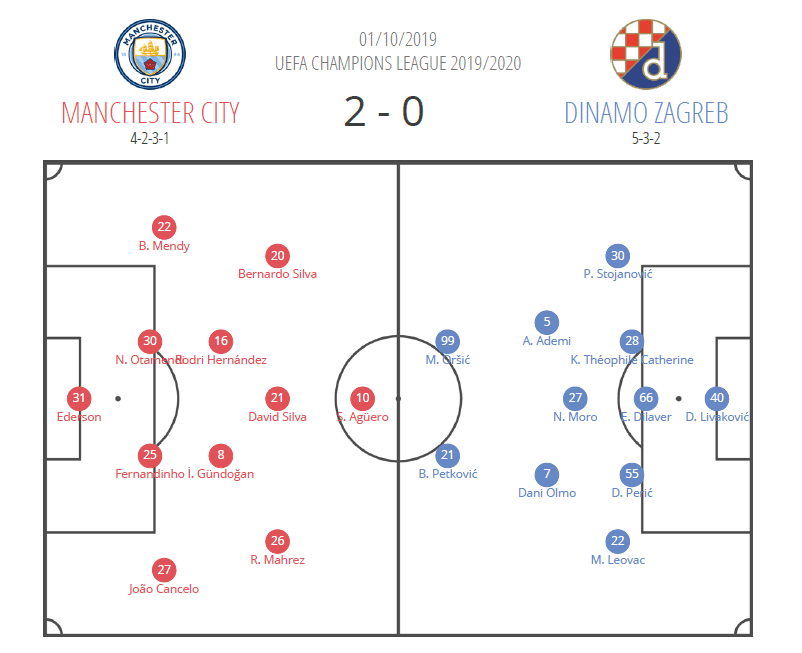
Dinamo Zagreb lined up in a 5-3-2 defensive formation with a back five of Petar Stojanović, Kévin Théophile-Catherine, Emir Dilaver, Dino Perić and Marin Leovac. Nikola Moro played as the defensive midfielder in front of the defensive line assisted together with Arijan Ademi and Dani Olmo beside him in midfield. It was Bruno Petković who played as a more central striker with Mislav Oršić often dropping into the line of the midfield to help out defensively. Dominik Livaković played between the posts.
Story of the stats
It was expected that City would steal a big share of the possession at the Etihad. In this game, the home side had a whopping 81% of the ball with the visitors playing a highly defensive game waiting to break on the counters. Although City, being the dominant side, registered 20 shots during the game, only six were on target. That’s merely a shot accuracy of just 30% for a team like Man City that boasts an elite lineup of players. Out of the 10 shots off target, eight were taken inside the 18-yard box including the one from Gündoğan that hit the woodwork. This shows that they severely lacked quality in finishing during this game which added a lot of pressure as the game progressed, well into the second half.
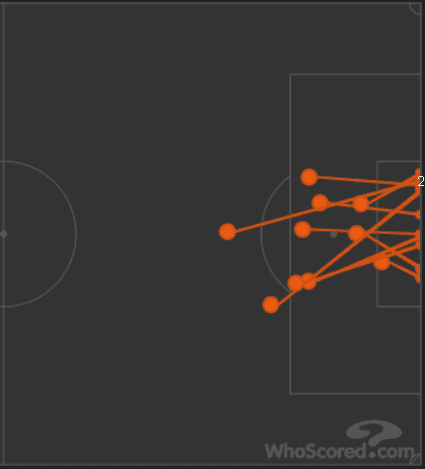
Against teams that sit in a low block the way Zagreb did, City tend to used width in their attacking organisation, especially in the final third, culminating in early, dangerous crosses into the box. We could see that this was part of Guardiola’s tactics in this game. City played 32 crosses into the box, but Zagreb were very efficient defensively in winning them aerially and clearing them. Dinamo won a staggering total of 44 clearances during the game which points towards a robust performance by the backline from dealing with crosses into the box. We also see that City’s tactics were not as successful as they had hoped it to be.
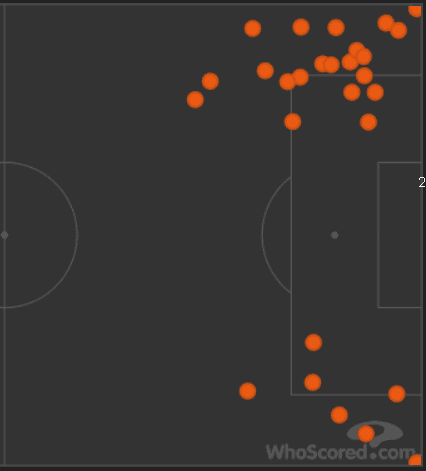
City’s positional structures during buildup
In this game, we saw Fernandinho and Otamendi interchange positions as the right and left centre-back respectively. Traditionally a holding midfielder, Fernandinho has been used as a centre-back in the past few games- most of the time, successfully. However, he did have a few errors defensively in his previous game against Everton where he was deployed as a left centre-back. The position is usually intended for Aymeric Laporte, the left-footed City defender, who is currently injured. Fernandinho being right-footed, an explanation could be that Guardiola preferred to have an orthodox central defender like Otamendi fill in the left centre-back role, with Fernandinho being more involved in building up from the right.
A vital unit of City’s build-up from the back is Rodri who is currently working to replace Fernandinho’s holding midfielder position in the long run. Rodri’s sense of understanding the opposition pressure and picking the right moment to drop in anywhere along the defensive line is pivotal to City’s build-up. When Rodri drops deeper, either between the central defenders or to either side of them, City essentially build up with three at the back.
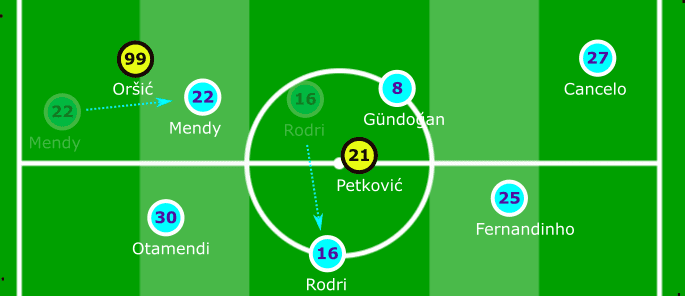
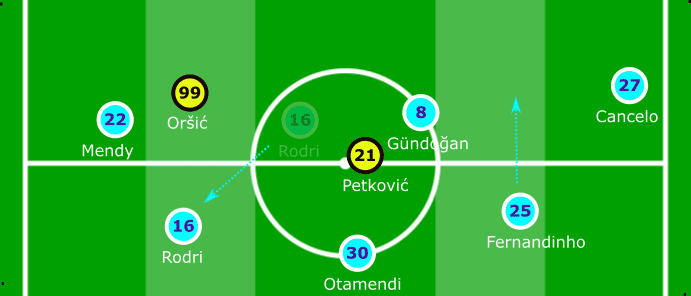
Having an extra player at the back allows the two centre-halves to spread out further into the half-spaces from which they can drive the ball forward in search of options between the lines, without risk of compromising the defensive structure. When City build up with a back-three, one of the midfielders (usually Gündoğan) drifts more centrally and it allows the full-backs to either move higher up or invert and position themselves more centrally.

City’s attacking organisation in the final third
Since Zagreb sat deep with a back line of five and a midfield row of three or sometimes four just in front as part of a low block, there was plenty of open spaces for City to utilise in their attacking phase. Agüero would occupy two of the Zagreb defenders at the front. David Silva operated in the left half-space and positioned himself between the two lines of the Zagreb block. Riyad Mahrez started off as the wide winger, but drifted inside and worked between the lines in the right half-space, leaving the wide corridor for Cancelo.
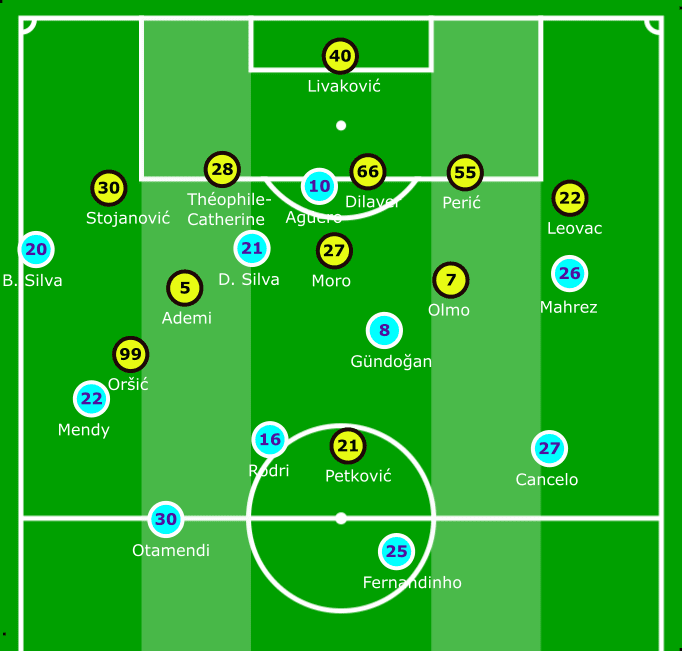
We usually see Bernardo Silva being played on the right where he is able to utilise his left foot to break inside. In this game, since Guardiola already had the left-footed Mahrez on the right wing, he tasked Bernardo on the left wing. The Portuguese international has gained a fine reputation of being tactically intelligent to play in multiple positions and exhibiting a sublime work-rate against strong teams.
However, in this game he appeared silent and uneventful on the left. Playing against a compact defensive team like Zagreb required more positional intelligence to be able to attract the press by playing between the lines. This role’s undisputed master is David Silva who displayed a phenomenal performance. Bernardo had to work with Benjamin Mendy in alternating occupation of the left flank and the left inner corridor depending on whether Mendy would play as in inverted full-back or overlap Bernardo.
Zagreb’s defensive organisation
Dinamo Zagreb, in their 5-3-2 defensive block were very efficient in tracking the offensive players who dropped lower to receive the ball in City’s build-up in a man-oriented fashion. They played defence by the textbook and always ensured they had enough bodies behind the ball.
The three central defenders for Zagreb were quite aggressive in stepping out of their line to apply pressure on players who played in the hole in front of the defence. But while one of the three stepped out, the full-back would drop back and get compact to cover. The central pivot Moro also played very close to the backline and would effectively slot in when one of his defenders stepped out. This made sure that the space behind the defence was always covered. The keeper Livaković took tremendous initiative in manning his box and displayed great decision-making in charging out to make saves in the few instances that Agüero or David Silva managed to break through.
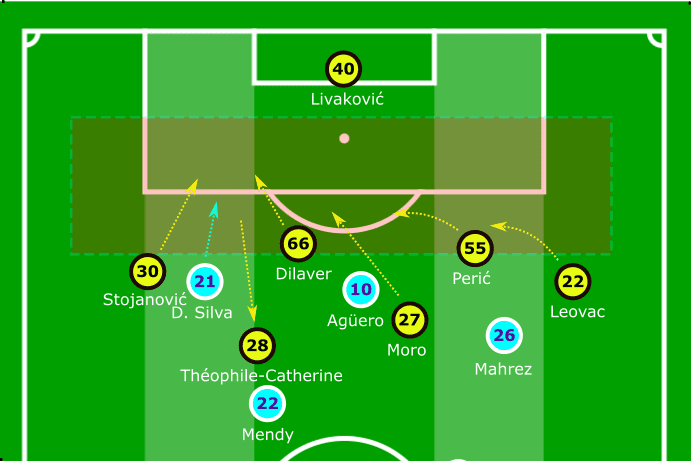
At the same time, Zagreb would always look for the opportunity to push up a couple of metres out of their half when they could. The trigger for Zagreb to press higher was usually a back pass. Because of City’s insistence on keeping the ball and circulating possession, City would often have to bring the ball all the way back to Ederson where the extra player would help them to regain numerical superiority.
David Silva’s masterclass
If Guardiola hailed the Spanish veteran as the best player to operate in tight spaces between the lines, this particular game was tailor-made for him to unlock. He rolled back the years with a vintage performance leading the side with the captain’s armband.
He was mainly positioned in the left half-space in the first half but gained a lot more positional freedom when Sterling was brought on. Since Zagreb kept the spaces very compact in front of their box, it was the job for a player like David Silva to pick the right moment to receive a pass between the lines of pressure and distribute the ball wide or play a key pass to Agüero. One of the key features of attacking a team using positional play is having superiorities behind opposition lines of pressure. In this figure, we can see David Silva’s excellent timing to pick a small space and receive the ball on the half-turn behind the disrupted defence so that his body orientation allows him to be facing goal-ward upon his first touch.
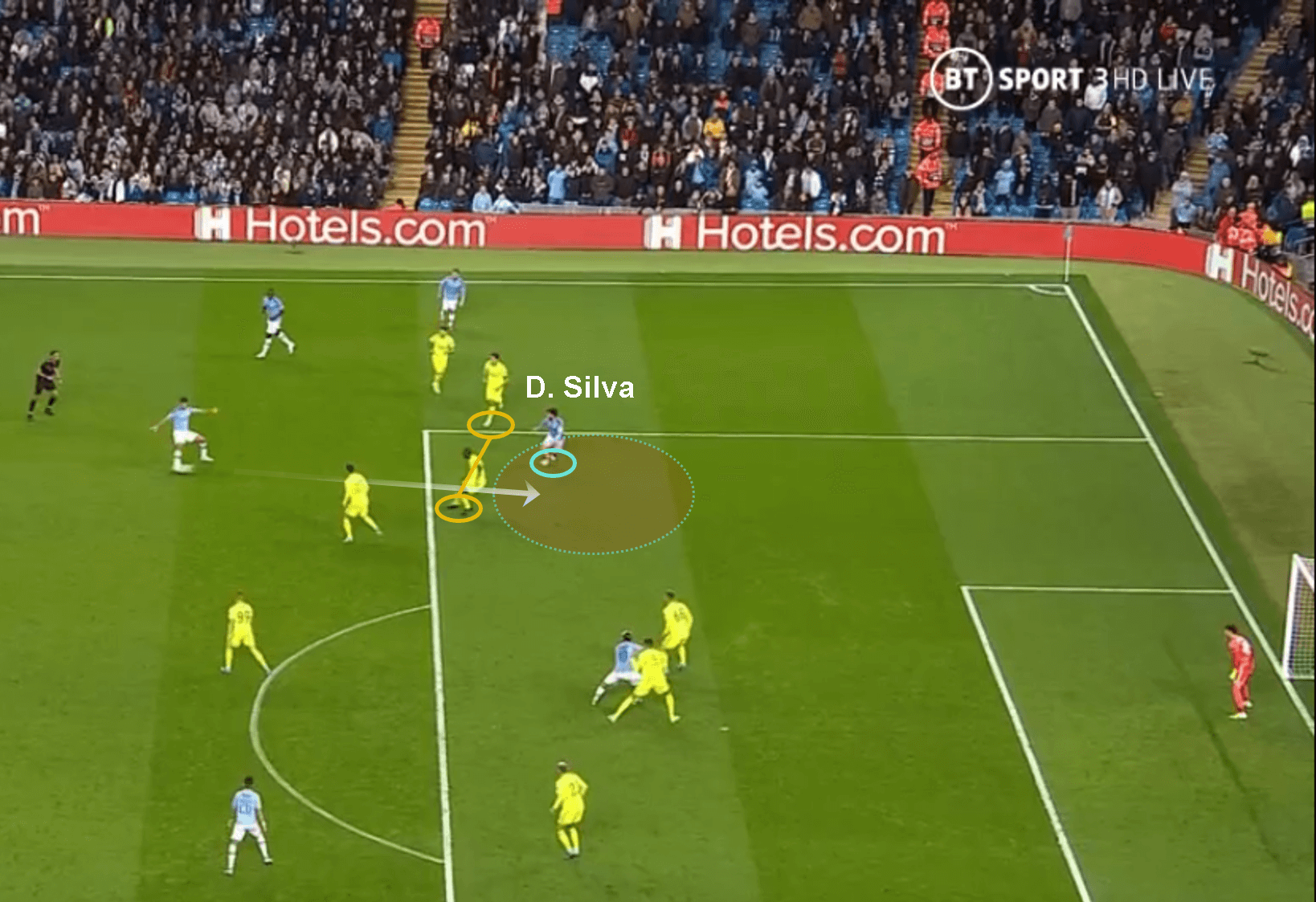
In another instance we see how Silva creates space for himself by his opposite movement. Once Mendy receives the ball out wide, Bernardo attacks forward drawing the defenders with him. David Silva also moves forward first and then checks back in the opposite direction making space for himself to receive the ball. Mendy has now two options to play – either to Bernardo into space or to David Silva’s feet.
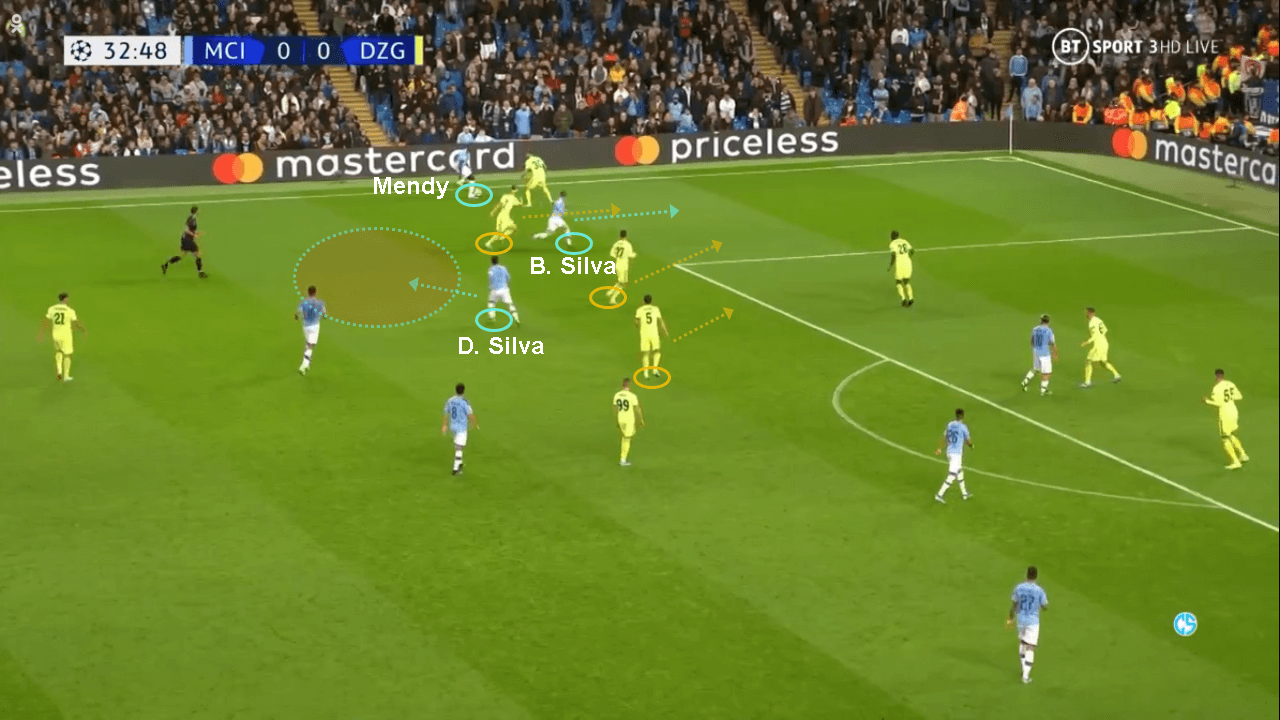
City too dependent on one side
We can already see in City’s positioning in their attacking organisation that they were quite asymmetric. There was a greater deal of asymmetry in their build-up and the chances that they created in this game than usual. City favoured the left side more heavily than the right. There were also more players positioned on the left side during attacks. As a result, they looked frustrated in the first half in being unable to convert any chances that they created and had to wait for Sterling to be brought on in the second half to break the deadlock.
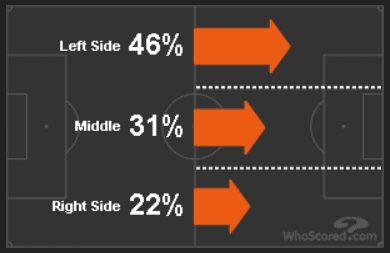
One of the main reasons for this was City’s full-backs. The cues for the full-backs to play inverted in the half-spaces were strictly positional, depending on where and when the spaces were created. However, Benjamin Mendy is still regaining his match sharpness and tactical understanding with his teammates after being out for a long period of time. We saw this by the timing of the crosses that he delivered. Although his crosses have great technical quality, there were not enough bodies in the box to attack them giving the Zagreb defenders always the advantage over City’s forwards.
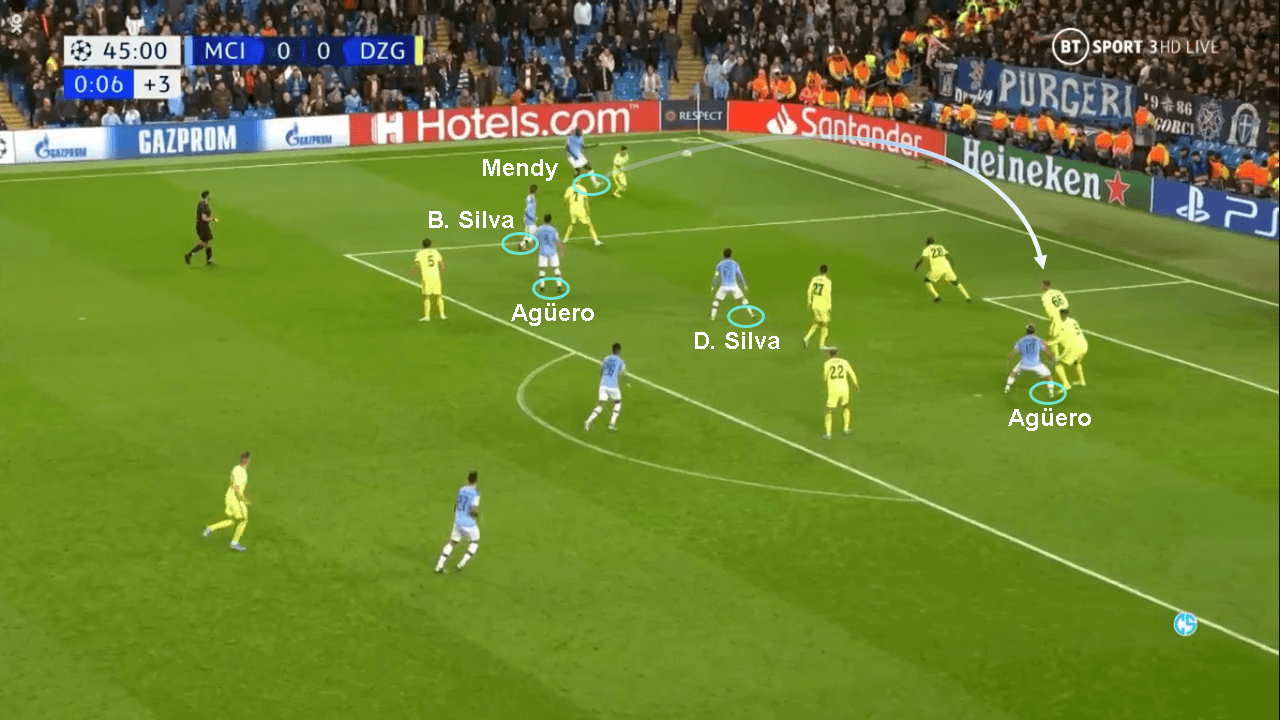
The same could be said about the freshman Cancelo. The Portuguese’s attributes are his pace and technical ability. But in this game having to fulfil Guardiola’s role of an inverted full-back seemed to leave him confused about his positioning at many times. Cancelo averaged 75 passes during this game but only played 38.67% of them in the final third. In a game played with 80% possession of the ball and thriving mostly in Zagreb’s half, Cancelo’s 29 out of 75 passes in the final third definitely falls short as we would expect him to be more attacking.

Mahrez, who usually occupies a wide role on the right when De Bruyne plays in midfield was constantly drifting inside and playing between the lines. But Cancelo didn’t seem to have clear instructions or the freedom to overlap the space behind Mahrez. As a result, the right side of the pitch could not be utilised for switch of play. The team was not stretching the width as efficiently on the right as it was on the left. This made Zagreb’s life easier as they had to focus on the threats coming only from one side.

Sterling saves the day
The spectacular form that the English international is currently having was evident in the way he added a fresh dynamic to City’s attack when he came on. First of all, he plays with a much higher tempo and spreads this onto the players around him. He came on to replace Bernardo Silva on the left, and you could see how City looked far more threatening.
He positioned himself in the space between the lines that David Silva was working in the first half. This allowed David Silva to play a more liberal role as a playmaker around the centre. In the second half, Mendy operated solely on the left wing as Sterling drifted into spaces inside. Gündoğan was also able to play deeper alongside Rodri as they both functioned more of a double-pivot in the second half.
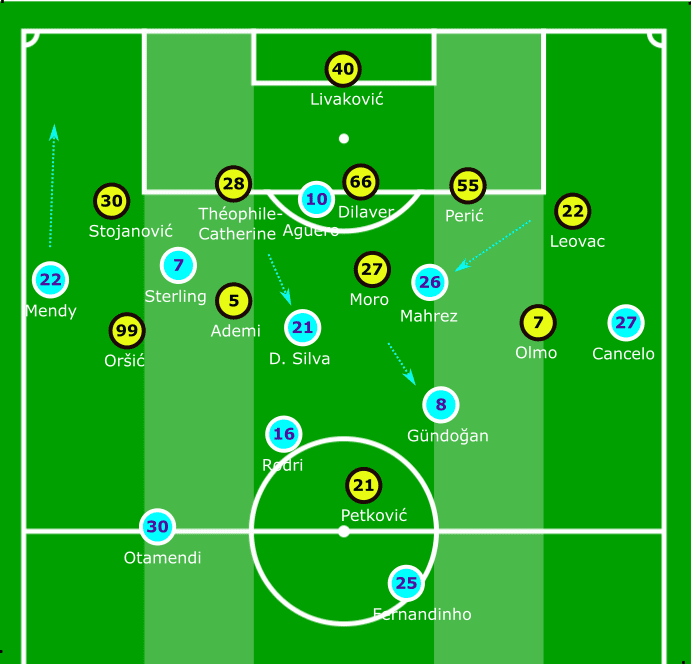
The two goals that City scored were progressions of set pieces. The first goal was a development from the second phase of a corner taken by City. It looked like a routine, straight-off-the-training-ground involving Gündoğan, Rodri, Mahrez and Sterling. Sterling and Mahrez showed great insight in reading the cues for third-man runs which enabled them to catch the Zagreb defence by surprise.

After the first goal, Zagreb made an attacking change with an aim to equalise. They switched to a back-four and played a 4-4-2 sacrificing their defensive compactness for attacking potential. As a result, there were more spaces in behind that opened up and what followed were multiple transitions for City to exploit. The second goal came off a 3 v 2 attacking transition executed to perfection by Sterling and Mahrez again and finished clinically by the newly brought on substitute – Phil Foden.
Conclusion
With wins over Shakhtar Donetsk and Dinamo Zagreb, Manchester City take six points and sit on top of their group table, looking to comfortably advance into the next stage. Dinamo Zagreb stand level with Shakhtar in terms of points and goal difference and thus the next games for both teams will be very crucial.
Guardiola’s side has no dearth of quality but some of his players are still struggling to adapt to his game model. As a result City have some players like Sterling, Mahrez and Rodri showing incredible form while others like Mendy and Cancelo playing catch-up with the rest of the pack. The players do need game time to be able to improve their coordination as a team, which is a challenge in itself for Guardiola. But with a long season ahead and unforeseen injuries or suspension expected, he would hope that all his guns are locked and loaded when he needs them.

If you love tactical analysis, then you’ll love the digital magazines from totalfootballanalysis.com – a guaranteed 100+ pages of pure tactical analysis covering topics from the Premier League, Serie A, La Liga, Bundesliga and many, many more. Buy your copy of the September issue for just ₤4.99 here





Comments